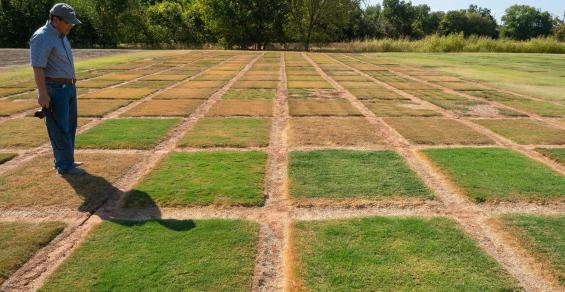Oklahoma may be known for its tallgrass prairies immortalized in classic Westerns, but for Oklahoma State University researchers, it’s the short grass that they want remembered.
Turfgrass, that is. Specifically Bermudagrass, known for its hardiness to the Oklahoma climate and its drought resistance, OSU varieties like Tahoma 31 and Northbridge have become a staple in not only lawns, but also major sports venues around the world, from Dodger Stadium and Churchill Downs to the 2008 Beijing Olympics.
OKC1876 and OKC3920 — the two latest Bermudagrass varieties developed at OSU — are examples of the extensive testing and experience needed to develop quality turfgrass.
Extensive research
When the Bermudagrass growing season, usually April-October, comes to a close, OSU scientists turn to lab and greenhouse testing over the winter months to make the best use of time in testing new experimental varieties.
This research process has taken place almost every year at OSU since the mid-1900s. Traditionally the entire process for the release of a new variety of turfgrass has been 10 to 15 years and requires an extensive greenhouse, lab and field screening and a testing process that can include more than 1,000 experimental plants.
See, New turf varieties released, OKC3920 resistant to winterkill
Yanqi Wu, OSU plant and soil sciences professor and plant breeder, said with his team working on thousands of experimental lines each year, new turf Bermudagrass varieties are usually released about every five years.
The research involving the two most recent varieties being released involved around 9,000 experimental plants.
“After initial evaluation, the breeder will select around 20 to 30 plants to be sent to collaborators across the U.S. to evaluate sod tensile strength, freeze tolerance, drought resistance, traffic tolerance, shade tolerance, disease resistance, golf ball roll distance and so on,” Wu said. “Every five years, the development team will submit two to 10 of their best selections to the National Turfgrass Evaluation Program where around 10 to 20 university scientists around the country will evaluate turfgrass performance and adaptation.”
The information gained from national testing is used to decide whether or not to release the experimental varieties to the public, and if so, to secure proprietary protection in the form of U.S. Plant Patents or Plant Variety Protection Certificates.
With a lot of hard work, a great deal of testing and some setbacks, scientists find the variety with the right genetic makeup to have strong color, durability, drought resistance, cold hardiness and more.
In the meantime, OSU scientists continuously pursue their molecular research on the two parent species, African Bermudagrass and common Bermudagrass, using DNA markers to study the genetic inheritance of important traits.
“We have developed most of the molecular marker tools in the world for Bermudagrass,” Wu said.
Improved varieties
With these tools, scientists map the genomes of different Bermudagrass varieties, and improved varieties of turfgrass are created.
“We have already developed more than 3,000 genetic markers, but there is more work to do,” Wu said. “It is all about little steps moving forward then combining all of those little steps to make larger progress.”
Wu said the research is a collaboration among OSU scientists, graduate students and technicians as well as scientists from other universities. Funding is provided by the U.S. Department of Agriculture, the U.S. Golf Association and the Oklahoma Center for the Advancement of Science and Technology.
“We want to always work toward better water conservation and water-use efficiency regarding grasses and sustainability traits,” Wu said.
Wu predicts the industry could probably save millions of dollars if more facilities used cold-hardy and water-use efficient grasses.
“I think our work has really produced some national impact. OSU grasses have been used in many places, and we are proud of that,” Wu said.
The process behind creating Oklahoma State University’s turfgrass.



